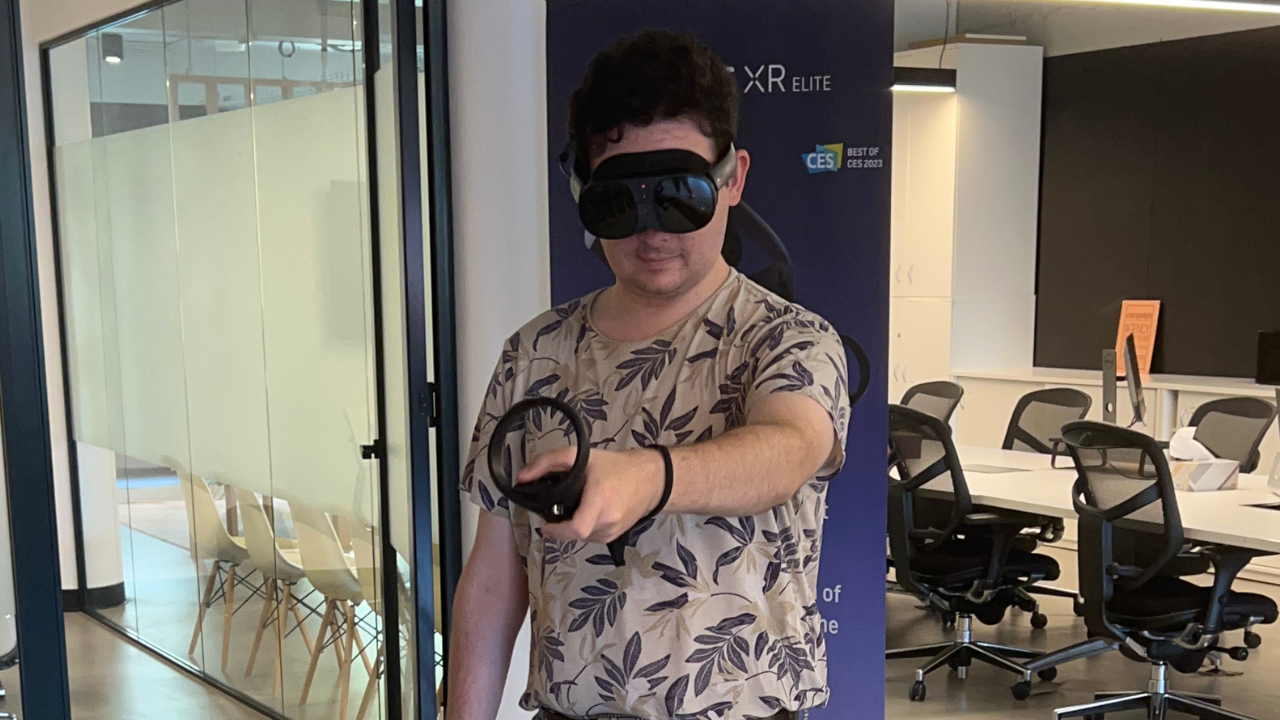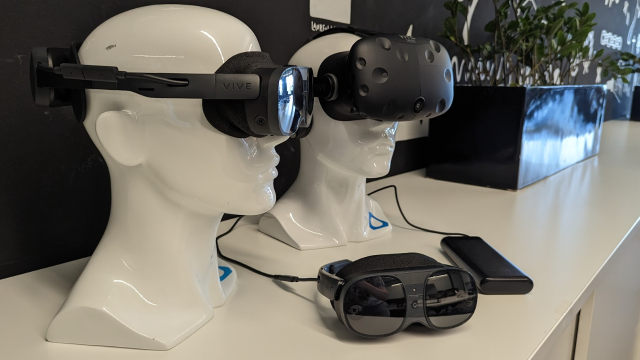HTC debuted the Vive XR Elite at CES 2023, and now, with the release upon us, I was offered a preview and hands-on of the headset.
The Vive XR Elite is HTC’s next big move in the VR space, and is the company’s first consumer-level headset with mixed augmented reality and virtual reality capability. It offers performance specs about on par with the HTC Vive Pro 2, except without the need for external tracking or a constantly connected power cable.
It’s most similar to the Meta Quest Pro ($2,449), except with $450 shaved off the price, omitting the face and eye tracking features (which HTC says will be available later this year as optional attachments).
I was very excited to give this thing a go. While I’m not the biggest fan of the price point, starting at $2,099, I realise that this isn’t meant to be an entry-level headset; it’s an enthusiast-level headset, intended for people that already like VR.
So, after a preview, here are my thoughts on the HTC Vive XR Elite.

So much in such a small package
Firstly, there’s no discounting just how small this headset is. At 625 grams, or 240 grams without the battery, it caught me off-guard how unevenly weight is distributed around the whole headset, battery and sides included, with the face module weighing it all down. This might seem like an obvious point to make, but when my touchstone for VR headset ergonomics is the popular Meta Quest 2 (which is larger and more easily grabbed), the weight at first had me worried about dropping or mishandling it.
And for the most part, the build quality is really impressive. The displays inside the headset are by far the clearest I’ve ever used in a VR kit, and that’s aided by the sophisticated adjustment settings (including eye spacing sliders and articulated magnification fine-tuning to reduce blur).
I was also impressed with the omission of an overhead strap and, of course, the ability to hot-swap batteries on the fly, without the headset turning off (a battery can be disconnected for up to 10 minutes without powering off). With the battery removed, you can add two struts to the side of the headset to wear it like glasses (provided there’s an external power supply connected via a cable). It had no trouble staying on my meaty head, but it kept falling of my editor’s smaller head.
That mode with the two struts is intended for lower movement activities, by the way, such as seated gaming (for driving sims) or watching content.
The only build quality concern I had was the part that presses against your head around your eyes. This is removable, to allow for easy access to the headset’s lens magnifiers for making adjustments, but it requires a solid click to lock in, which had me worried about damaging the headset.

Merging realities
I gave three games a go while playing with the HTC Vive XR Elite. The first I’ll mention was a mixed-reality painting game, where I could paint on an easel and look at a marble bust, all in mixed reality. That means the virtual elements (the easel and bust) were all visible as objects in the room to me, as augmented objects displayed via the headset. I could walk around these objects freely, and while it was quite a limited experience, it has me excited about what this headset could potentially pull off.
@gizmodoau Hands on with the #HTC #VIVE XR ELITE headset, showing off its augmented reality and pass through features. #VR #AR #Tech #gaming #HPRadicalReuse
Next up was another mixed reality game, in which one of my controllers became a sci-fi hero of some sort, flying around within my visible space around me, and shooting wherever I aimed the controller (with enemies shooting back). This was also very cool, with all of the objects displayed rendering within the room, so I could get in close and check them out, or dodge the attacks that were flung at me. Think Space Invaders in virtual reality.
Finally, I gave Superhot VR a go. This wasn’t to test out the headset’s mixed reality power, but it was so that I could pick up on how similar this headset is to other VR headsets I’ve used.
And it really did impress. Internal tracking was consistent, gameplay was smooth (streamed locally over Wi-Fi 6e from a modem and laptop about two metres from me) and, as I said earlier, the displays knocked it out of the park.
Unfortunately, the pre-production headsets I got to try out didn’t have the depth sensor-enabled, which would have allowed for more detailed mixed-reality experiences (such as keyboard presses on a physical keyboard translating to a monitor in the headset). This meant that I was unable to try out any virtual desktop applications and give the headset a go at my daily workload (something I’ve definitely been excited to try out). The HTC team told Gizmodo Australia that the production model will have this capability. If you’d like an idea of what I’m talking about, check out the video below.
But as far as gaming went, it was a treat.
Final thoughts
At this stage, I can see the appeal of the HTC Vive XR Elite, but this was just a preview. HTC has a lot to gain here with a headset well below the price of its closest rival, but the most time I got with it was 30 minutes.
I still need to be convinced of how this headset can be used in a work capacity. Mixed reality gaming is a cool gimmick, and this thing has virtual reality aced (from what I can tell), however, apart from the satisfying form factor, it’s difficult to tell how this headset slots into the larger XR market when Meta Quest 2 offers a similar experience, albeit with less impressive specs and build quality.
But the form factor rules, and it’s probably what you should be most excited about. If it’s a symptom of other headsets to come, then VR’s most painful hurdle (the bulkiness) might be over.
Where to buy the Vive XR Elite?
The HTC Vive XR Elite is available for preorder now, starting at $2,099, with deliveries beginning February 25.
